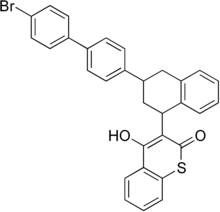Difethialone
Appearance

| |
| Names | |
|---|---|
| IUPAC name
3-[3-[4-(4-Bromophenyl)phenyl]-1-tetralinyl]-2-hydroxy-4-thiochromenone
| |
| Identifiers | |
3D model (JSmol)
|
|
| ChemSpider | |
| ECHA InfoCard | 100.118.383 |
| KEGG | |
PubChem CID
|
|
| UNII | |
CompTox Dashboard (EPA)
|
|
| |
| |
| Properties | |
| C31H23BrO2S | |
| Molar mass | 539.49 g·mol−1 |
Except where otherwise noted, data are given for materials in their standard state (at 25 °C [77 °F], 100 kPa).
| |
Difethialone is an anticoagulant used as a rodenticide.[1] It is considered a second generation agent.[2]
In May 2008, the United States Environmental Protection Agency banned the use of difethialone in consumer-use rodenticide products and also for exterior use by commercial applicators.[3][4]
References
- ^ Nahas K, Lorgue G, Mazallon M (1989). "Difethialone (LM-2219): a new anticoagulant rodenticide for use against warfarin-resistant and -susceptible strains of Rattus norvegicus and Mus musculus". Annales de Recherches Vétérinaires. 20 (2): 159–64. PMID 2751229.
- ^ Saravanan K, Kanakasabai R, Thiyagesan K (June 2003). "Field evaluation of difethialone, a new second generation anticoagulant rodenticide in the rice fields". Indian Journal of Experimental Biology. 41 (6): 655–8. PMID 15266918.
- ^ EPA, OCSPP, OPP, US (2014-03-04). "Restrictions on Rodenticide Products". www.epa.gov.
- ^ "Regulations.gov". www.regulations.gov.
